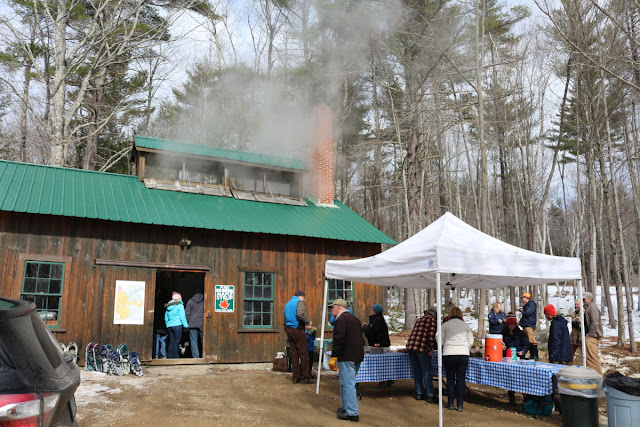Sugar season is in full swing right now and central New Hampshire is having an excellent year. Yesterday I went to the Maple Sugar Day at Burleigh Farm in Holderness, which was holding demonstrations of their sugaring process, tours of the sugar bush, and most importantly, tastings!
 |
| Sugar Shack at Burleigh Farm |
The event was sponsored by the Squam Lakes Conservation Society, Squam Lakes Association, and the Lakes Region Conservation Trust which holds the conservation easement on 1500 acres of forest and farmland that protects the home of all those maple trees. A knowledgeable team was on had to explain the process and answer everyone's questions.
 |
| Matt Evans describes the complete process from tree to jug |
 |
| The final product ready for tasting |
 |
| Yum! |
The farm has taps in 3400 sugar maples which all flow via tubing, under vacuum, directly to the sugar house, allowing them to produce over 1600 gallons of maple syrup each year.
 |
| Collecting sap straight from the tree |
One benefit of this system is that the sap doesn't contain all the bark, bugs, and other detritus that found its way into the sap with open collectors. Unless, of course, a coyote or a fox decides to chew on the tubing and tear it open.
With that quantity of sap to process, the sugar house has been updated with modern technology. The raw sap is processed through a reverse osmosis membrane system which concentrates the sugar content from about 2% straight from the tree up to 14% after two passes through the system.
 |
| Peter Webster explains the membrane system |
This greatly reduces the amount of boiling required. After being concentrated by reverse osmosis it is finished in a good old fashioned open boiler, but heated with oil or propane rather than wood.
 |
| The final boil |
But from the outside, it has all the appearance of a traditional New England sugar shack.
Later, back closer to home, I saw that the Chemung Gang sugar shack was boiling away as well, still doing it the good old fashioned way!
The lakes sure don't look much like spring, but nonetheless there was a nice reminder that spring is coming: I saw my first loon of 2018 fly overhead one afternoon - apparently we are not only ones watching the lakes, waiting to see some open water. And wait we will, as there are still 21 inches of ice on Lake Wicwas.
 |
| Thick ice remains even where it is hanging in air because the lake has dropped |
 |
| It's going to be a while before this mass of snow and ice lets the loons come home |
That photo was taken after the most recent snow storm (for us that is - we missed the fourth nor'easter which hit only the southern part of the state). What is so intriguing for me is how tracks in the snow change over time. Those depressions formed by snow shoes were completely inverted after just a few days of wind and sun acting on the snow - five days later those indentations had become convex bulges sticking up above the surrounding snow.
 |
| Wind and sun etched away the softer snow, leaving the packed tracks protruding up |
After the storms we had more perfect blue-sky days luring me out onto the trails.
 |
| More apples still to fall for the hungry spring animals |
I knew apples must still be around due to seeing fox and coyote scat containing apple skin, but it was neat to see some still hanging on their branches.
A final note, as bears are one of those hungry, spring animals, NH Fish and Game reminds us:
Spring is Here: It's Time to Take Take Down Birdfeeders!
 |
| Photo by NH Fish and Game |
Those loons aren't the only animals out in search of spring.














The Mill Dam in Page Pond Town Forest looks so much like the one in my backyard. Wouldn't doubt if they were built around the same time.
ReplyDeleteYou're probably right. Do you have any historical information on it?
Delete